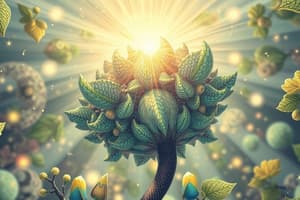Podcast
Questions and Answers
¿Dónde tienen lugar las reacciones de la fotosíntesis?
¿Dónde tienen lugar las reacciones de la fotosíntesis?
- En el estroma (correct)
- En los tilacoides
- En las membranas externas
- En los grana
¿Cuál es la función principal de los cloroplastos?
¿Cuál es la función principal de los cloroplastos?
- Realizar la fotosíntesis (correct)
- Producir ATP
- Dividir las células
- Almacenar nutrientes
¿Cuáles son los principales pigmentos fotosintéticos utilizados por las plantas verdes?
¿Cuáles son los principales pigmentos fotosintéticos utilizados por las plantas verdes?
- Clorofila a, clorofila b, xantofilas (correct)
- Clorofila a, carotenoides, xantofilas
- Clorofila a, clorofila b, carotenoides
- Clorofila a, clorofila b, clorofila c
¿Cuál es la función del ATP en la fotosíntesis?
¿Cuál es la función del ATP en la fotosíntesis?
¿Cuál es el proceso que utiliza el gradiente de protones a través de la membrana de los tilacoides para sintetizar ATP?
¿Cuál es el proceso que utiliza el gradiente de protones a través de la membrana de los tilacoides para sintetizar ATP?
¿Qué estructura de los cloroplastos contiene los pigmentos fotosintéticos?
¿Qué estructura de los cloroplastos contiene los pigmentos fotosintéticos?
¿Cuál de las siguientes opciones describe correctamente el papel de la clorofila en la fotosíntesis?
¿Cuál de las siguientes opciones describe correctamente el papel de la clorofila en la fotosíntesis?
¿Cuál de los siguientes compuestos se produce durante las reacciones de luz de la fotosíntesis?
¿Cuál de los siguientes compuestos se produce durante las reacciones de luz de la fotosíntesis?
¿En qué parte de la célula vegetal ocurre el ciclo de Calvin?
¿En qué parte de la célula vegetal ocurre el ciclo de Calvin?
¿Cuál de los siguientes productos no se genera directamente durante la fotosíntesis?
¿Cuál de los siguientes productos no se genera directamente durante la fotosíntesis?
¿Qué proceso ocurre durante las reacciones de luz de la fotosíntesis?
¿Qué proceso ocurre durante las reacciones de luz de la fotosíntesis?
¿Cuál de las siguientes afirmaciones sobre el ATP y el NADPH es correcta?
¿Cuál de las siguientes afirmaciones sobre el ATP y el NADPH es correcta?
Flashcards are hidden until you start studying
Study Notes
Photosynthesis: Capturing Energy from Sunlight to Power Life on Earth
Overview
Photosynthesis is a critical biological process that powers life on our planet. Through photosynthesis, plants, algae, and some bacteria convert sunlight, water, and carbon dioxide into glucose, oxygen, and auxiliary products. This process is essential for maintaining life and has had significant impacts on the composition of Earth's atmosphere. Photosynthesis can be broadly divided into two main components: the light reactions and the Calvin cycle.
Light Reactions
The light reactions occur in the thylakoid membranes of chloroplasts within plant cells. These reactions involve the splitting of water molecules (H2O) into oxygen gas (O2), electrons (e−), and protons (H+). The energy from sunlight is captured by chlorophyll pigments present in the thylakoids, which then transfer this energy to initiate a series of redox reactions. This results in the production of adenosine triphosphate (ATP) and nicotinamide adenine dinucleotide phosphate (NADPH), both crucial for powering subsequent biochemical processes.
Calvin Cycle
The second part of photosynthesis is known as the Calvin cycle. In this process, the ATP and NADPH generated during the light reactions are utilized to convert carbon dioxide (CO2) into glucose (C6H12O6) through a series of enzymatic reactions. These reactions take place in the stroma, the fluid-filled space surrounding the grana (stacks of thylakoids) within chloroplasts. The resulting glucose can be used immediately by plants or stored for later use.
Chloroplasts: The Site of Photosynthesis
Chloroplasts are specialized organelles found in the mesophyll cells of leaves, the primary site of photosynthesis. Each leaf cell contains approximately 100 chloroplasts, which are responsible for carrying out the light and dark reactions of photosynthesis. Chloroplasts have a unique structure consisting of outer membranes, an inner membrane called the thylakoids, and a stroma. The thylakoids contain chlorophyll pigments that absorb light, while the stroma houses enzymes involved in the Calvin cycle.
Photosynthetic Pigments
Chlorophyll is the most abundant and widely distributed photosynthetic pigment. Green plants primarily use chlorophyll a, chlorophyll b, and xanthophylls as accessory pigments. These pigments absorb wavelengths within the blue and red regions of the electromagnetic spectrum, allowing them to capture a broad range of solar radiation.
ATP Production
ATP serves as the primary carrier of energy within biological systems. During the light reactions of photosynthesis, ATP synthase uses the proton gradient generated across the thylakoid membrane to synthesize ATP from adenosine diphosphate (ADP) and inorganic phosphate (Pi). This ATP fuel drives various biochemical processes within plant cells.
Conclusion
Photosynthesis is an essential process that sustains life on Earth. Through the conversion of sunlight, water, and carbon dioxide into glucose and oxygen, photosynthetic organisms provide the energy and nutrients necessary for their own survival as well as for other creatures higher up in the food chain. By understanding the intricacies of this vital biological process, we can appreciate its significant impact on our planet's ecosystems and the interconnectedness of all living beings.
Studying That Suits You
Use AI to generate personalized quizzes and flashcards to suit your learning preferences.




